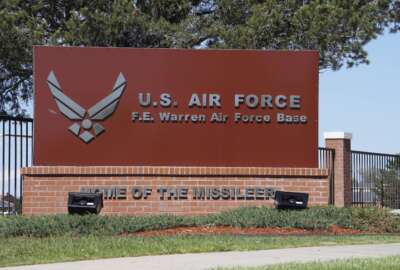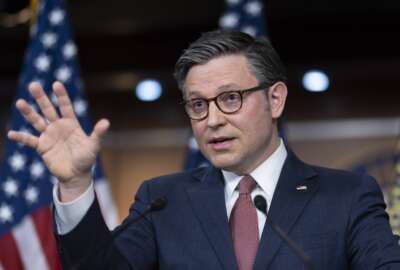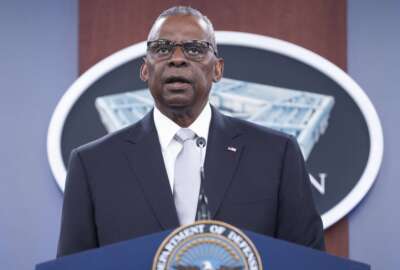Hubbard Radio Washington DC, LLC. All rights reserved. This website is not intended for users located within the European Economic Area.
New VA secretary promises flatter, more open organization
Robert McDonald, the new secretary of the Veterans Affairs Department, says the biggest thing he's learned over his first seven weeks on the job is that the org...
Robert McDonald, the new secretary of the Veterans Affairs Department, said the organization he took over seven weeks ago has a leadership structure that is far too bureaucratic, overly insular and closed-off to internal critiques.
While he doesn’t yet have a detailed plan to fix those problems, he’d strongly prefer that the 340,000 employees he oversees stop referring to him as “Mr. Secretary.” He prefers “Bob.”
In that spirit, during his first press conference as secretary on Monday, McDonald gave a room of reporters his personal cell phone number, saying VA needs to open its lines of communication both internally and among its outside stakeholders. (It’s not clear whether he knew his remarks were also being broadcast live on C-SPAN.)
Speaking a day before he was scheduled to testify for his first major oversight hearing as the leader of a department that’s been embroiled in scandal, McDonald said the department’s culture has become so closed that it’s entirely possible that no one at VA’s headquarters knew about the pervasive scheduling practices staff in Phoenix and elsewhere used to hide patient waiting times.
“When I was going around, it seemed to me that employees thought of the hierarchy of VA as a pyramid. Being the secretary, everybody would rise when I entered the room, and everybody would call me ‘sir.’ I got the impression that employees thought that the secretary was on the apex of the pyramid and that the veterans were on the bottom of the pyramid. I don’t like that idea,” McDonald said. “So one of the things I’m trying to do is create a non-hierarchical organization — one where the veteran is on top.”
Embrace constructive dissent
McDonald vowed to rebuild trust between VA and veterans and other stakeholders by first redefining the trust relationship within the agency itself.
“We’re working hard to create and sustain a climate that embraces constructive dissent, that welcomes critical feedback and that ensures compliance with legal requirements. That climate mandates commitment to whistleblower protections to all employees,” he said. “I’ve told employees that I want every employee to criticize what we do and help us improve. I want everybody to become a whistleblower in their own way. We’ve established and introduced a preliminary accountability review team to ensure leadership accountability for improprieties related to patient scheduling and access to care, whistleblower retaliation and related matters that impact public trust in the VA.”
On the accountability front, Congress passed and President Barack Obama signed legislation last month creating a streamlined process for VA to remove underperforming or misbehaving Senior Executive Service employees.
McDonald has come under some criticism from Capitol Hill and elsewhere for not making use of that new law to fire any SES workers so far. He said more than 30 personnel actions already are in the pipeline, but the new law and its authorities also have been widely misunderstood.
McDonald said he was focused more on creating “sustainable” accountability than on quickly firing a few executives.
“The new law doesn’t allow VA to fire senior leaders without cause, nor does it guarantee that VA’s senior executives will be fired even if we’re seeking to remove them,” he said. “What it does is shorten the time a senior executive proposed for removal has to appeal VA’s decision. It doesn’t do away with the appeal process or guarantee that our decisions will be upheld on appeal. When evidence of wrongdoing is discovered, we will hold employees accountable, and we will take the action as quickly as law and due process allows us to take. There are over 100 ongoing investigations of VA facilities right now by the VA Office of the Inspector General, by the FBI, by the Department of Justice, by the Office of Special Counsel and others. In each case, we’ll await the results, and we will take the appropriate disciplinary action when all the facts and evidence are known.”
Digital Services team
With regard to organizational changes, McDonald offered only a few details of his plans to flatten VA’s structure.
He said he wants the department to stop performing functions that don’t add value to veterans, so that those resources can be redirected elsewhere.
For example, McDonald said he plans to upend a structure in which different VA mission areas each have their own geographic divisions and areas of responsibility.
“If you look at the structure of VA, you find that we have nine different geographic maps for how we’re organized,” he said. “Every part of the VA has a different geographic map, a different hierarchical structure. We’re gonna be looking at how we reorganize the VA so that when the veteran looks at the organization, the veteran knows how to connect and how to get things done. We are too complicated from the veteran’s standpoint.”
Also on Monday, VA announced it would create a new “digital services team.” The agency will recruit a new crop of what it said would be “the nation’s top technologists” to overhaul the way the department lets veterans access services electronically.
Current service delivery mechanisms, McDonald said, aren’t up to par.
“Right now, if you go to the Veterans Affairs website, you’ll find that there are 14 different websites that require a different username and a different password for veterans to access the VA. That’s just flat wrong,” he said. “We’ve got to make it easier for the veteran to access the VA through one website, one username, one password.”
Beyond general principles, McDonald said little else about the specific steps he’ll take to reorganize VA, but promised the final decisions will only be made after extensive input from Congress, labor unions and veterans’ service organizations, with the ultimate objective of creating services where and when veterans need them.
“We have one facility that set up 12 customer service representatives that wore red coats so that when the veteran walked in the door, they immediately had people there to help them. Those people had iPads so they could contact the doctors, nurses, whoever they needed, immediately. For some reason, they went from 12 of those people down to two,” he said. “We need to have more people interacting with the veteran.”
McDonald said VA is piloting a program in Little Rock, Arkansas, in which VA’s benefits organization and its healthcare staff will create a single point of contact where veterans can get healthcare services from the Veterans Healthcare Administration and the Veterans Benefits Administration without having to make separate appointments.
“It’s very simple. You look at it from the standpoint of the veteran, and what does the veteran want? Does the veteran want to have to go through bureaucracy? Do they want to have to have 14 different usernames and passwords? Do they want to worry about nine different geographic maps? Do they want to worry about a hierarchy? No. They want service, and that’s what we want to provide,” McDonald said.
RELATED STORIES:
VA chief makes 1st hospital visit amid scandal
VA referrals to private doctors on rise
IG: Shoddy care by VA didn’t cause Phoenix deaths
Copyright © 2024 Federal News Network. All rights reserved. This website is not intended for users located within the European Economic Area.
Jared Serbu
Jared Serbu is deputy editor of Federal News Network and reports on the Defense Department’s contracting, legislative, workforce and IT issues.
Follow @jserbuWFED
Congress unveils $1.2 trillion plan to avert government shutdown and bring budget fight to a close
Related Topics





